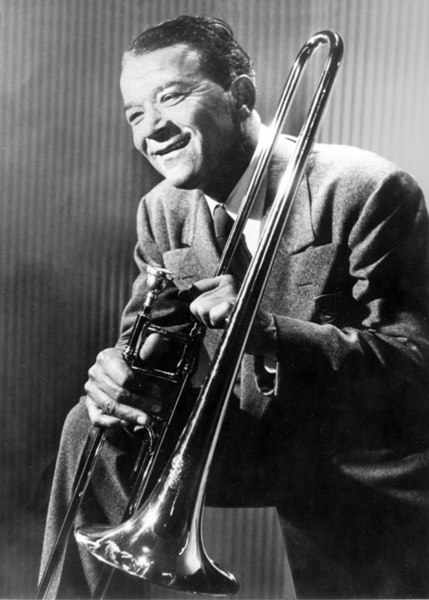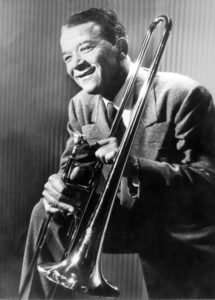Kid Ory
Trombonist and bandleader Kid Ory, a pioneer of the traditional New Orleans Jazz style, played a key role in the New Orleans Revival of the 1940s.

THE HISTORIC NEW ORLEANS COLLECTION
Edward "Kid" Ory.
Trombonist and bandleader Kid Ory, a pioneer of the traditional New Orleans jazz style, played a key role in the New Orleans Revival of the 1940s. He is credited as the leader of the first Black New Orleans jazz band to make a recording, and Ory’s recording of “Creole Song” in 1944 is the first documented performance of a jazz-informed song sung in Creole patois. During his long musical career, he worked with jazz greats such as Louis Armstrong, Joseph “King” Oliver, Jimmie Noone, Ferdinand “Jelly Roll” Morton, and Sidney Bechet.
Early Life
Born December 25, 1886, Edward “Kid” Ory was raised on the Woodland Plantation in LaPlace, in St. John the Baptist Parish, where he began his musical career. Much can be learned about the complex commingling of ethnic diversity and racial ambiguity in Louisiana culture by inquiring into the ancestry of Ory’s parents. His father was a white man of French ancestry named Ozeme John Ory. His mother, Octavie Devezin, was Afro-Spanish and Native American. Under most nineteenth-century protocols, Ory would have been considered an octoroon, meaning that he had one African-heritage grandparent. After the implementation of segregation, however, that meant he was legally Black.
Ory’s musical career began on the Woodland Plantation with a rag-tag group of musical “wannabes,” performing at fish fries on homemade instruments. By 1910 he had saved enough money to buy a trombone and moved to New Orleans with his Woodland Band, just in time to fill the vacuum resulting from jazz cornetist Charles “Buddy” Bolden’s nervous breakdown and incarceration in the Jackson State Asylum in 1907. Within a few years his original “running pardners” had all been replaced by such future jazz stars as Joe Oliver, Louis Armstrong, Johnny and Baby Dodds, Jimmie Noone, and Sidney Bechet, who were attracted by Ory’s innate understanding of what it took to satisfy the public and his ability to outsmart other band leaders in getting jobs. A case in point was his strategy at cutting contests, where jazz bands riding around town on horse-drawn furniture wagons would meet and compete for the crowd’s approval. Ory found that using a truck in such encounters provided an advantage, especially when the noise of the engine frightened the opponent’s horses, causing them to buck, which distracted his musical adversaries. Of course, with a motorized wagon, he could also outrun competitors when necessary, particularly if they were gaining the upper hand.
Time spent in the streets on wagons or trucks had other implications as well. Ory became internationally recognized as the progenitor of tailgate trombone style, so named because the instrument’s slide could easily become a lethal weapon in the wrong hands, thus necessitating positioning the trombonist at the tail end of the wagon, away from the other musicians. Edmond Souchon once remarked that Ory had the “foulest” tone of any jazz trombonist he had ever heard, which he meant as a compliment. In New Orleans-style jazz, imprecision can be a value unto itself, as long as it is done with feeling.
Life Outside Louisiana
After becoming the most popular jazz bandleader in the city, Ory left for California in the fall of 1919, at the height of his success, for health reasons—purportedly due to emphysema. In truth, he fled because of a business deal gone sour with a Sicilian nightclub owner. When the cornet player Joe Oliver moved to Chicago in 1918 after being arrested several times on the job with Ory, young Louis Armstrong took his place. The band performed at Pete Lala’s Theatre on Claiborne Avenue, drawing so well that Ory decided to run the show himself. He rented Economy Hall (also known as Cheapskates’ Hall) in Tremé, along with nearby Cooperators Hall, which he kept dark, to eliminate any competition. But Lala was well connected, and soon the police started showing up at Economy, harassing the customers waiting to get inside. That is when Ory learned that one can become too smart a businessman, and he was fortunate to escape with nothing worse than a bruised ego.
Shortly after Ory made his Nordskog recordings in Los Angeles in 1922, Armstrong left New Orleans to join Joe Oliver in Chicago, making recording history himself with the Creole Jazz Band in 1923. When he organized his own band, the Hot Five, in 1925, he sent for Ory, his favorite trombonist. It turned out that Armstrong wasn’t the only one who felt that way. Between 1925 and 1928, Ory recorded simultaneously with Armstrong, Joe Oliver’s Dixie Syncopators, and Jelly Roll Morton’s Red Hot Peppers, making him the busiest session trombonist in the Windy City. He saved his money during the 1920s, and when the Depression lowered the curtain on the Jazz Age, Ory returned to California, where he worked as a postal sorter and ran a chicken ranch. He was retired from music altogether, except when the trombone was needed to intimidate errant chickens that refused to behave or lay enough eggs. It seemed like the end of the line, but it was not.
Career Revival
Cleaning out chicken coops was a particularly odious assignment for a trombonist who had ridden the recording boom of the 1920s to stardom with Louis Armstrong and Jelly Roll Morton. Ory had certainly never been one to eschew hard work—after all, he had grown up on a sugarcane plantation—and he knew that every season brings change. In fact, fortune was about to give the Kid the sweetest comeback imaginable—a return to the spotlight. What changed his circumstances dramatically was a movement inspired by “hot” record collectors and writers to reignite interest in “authentic” New Orleans jazz as an antidote to the popularity of swing and the emergence of bebop in the 1940s, a phenomenon usually referred to as the New Orleans Revival.
The rediscovery of trumpeter Bunk Johnson by the authors of Jazzmen in 1939 got the ball rolling and, by the time it reached California in 1943, some major show business figures were interested in promoting the Revival for reasons of their own. Orson Welles, who had scared the nation with his “Martian invasion” radio stunt War of the Worlds in 1938 and then redeemed himself with the critically-acclaimed film Citizen Kane in 1941, had transferred his Mercury Theater radio show to Hollywood, and he was looking for a hook that would generate publicity. He enlisted the services of his friend Marili Morden, the beautiful proprietress of the Jazz Man Record Shop in Los Angeles, to find a band that could deliver “the original sounds of jazz,” and she came up with Ory. Welles later delivered a rather negative assessment of the purists who followed the New Orleans Revival: “There’s something of the opium eater in your jazz cultist. His enthusiasm affects him like a drug habit, removing him, it seems, from the uninitiated and less paranoid world about him and encouraging many of the attitudes of full-blown megalomania.” Of course, this did not stop him from using Ory as his pied piper to boost rating for his radio shows.
In 1943 Ory and some of his musical friends had already accompanied Bunk Johnson at a concert at the Geary Theater in San Francisco. A year later he had his own radio show (sponsored by Standard Oil, in addition to the Mercury Theater radio stints) in Los Angeles that gave him widespread public exposure. Soon he was in demand at nightclubs throughout the city, which Morden wrote about in a letter to her friend Alma Hubner, the daughter of the Chilean ambassador to Australia: “It is now quite impossible to have anything resembling solitude when listening to Kid Ory’s band—in fact, one is lucky to get a seat within listening distance … many people have been telling me for months that the band was fine but wouldn’t draw enough business for anyone to risk hiring them. Other night club owners … are now trying to lure them away from the Jade.” People could not help but remark that the Kid was doing quite well for his age (almost 58).
In 1944 Ory also resumed recording activity, including songs that he knew from childhood but had overlooked in his earlier career with Armstrong, Oliver, and Morton. He began with “Creole Song” (a.k.a. “C’est l’autre Can Can,” a story about a gossip in Storyville) for Nesuhi Ertegun’s Crescent label, an independent record company that referenced both Ertegun’s love of the Crescent City and his Turkish heritage (his father was the Turkish ambassador to the United States). It was the first documentation of a jazz-informed song from the early days sung in Creole patois, which was Ory’s native tongue, and it wouldn’t be the last. Over the course of the next few years, he recorded “Blanche Touquatoux” (about a Creole woman trying to pass for white and failing), “Eh la Bas” (a celebration of overindulgence), and “Creole Bo Bo” (about a well-deserved spanking, although not in Storyville). Such material lent substantially to Ory’s exotic appeal as a Creole (and it helped to keep the Creole language alive), representing a French connection to jazz that was abiding and basic to his identity. Not even Bunk Johnson could match that.
In the 1950s Ory made trips to France in order to see where his family came from. He was treated royally and made a short film called L’Homme de la Nouvelle Orléans there in 1958. (This was not his first film; he had previously appeared as part of Louis Armstrong’s band in the film New Orleans, released in 1947). But perhaps the strangest twist in his saga came late in the following decade, when a tune he had written and recorded in the 1920s, “Muskrat Ramble,” was recreated as “Feel Like I’m Fixin’ to Die Rag” by Country Joe and the Fish and became a huge hit as an anti-Vietnam War protest song. The “Muskrat Ramble” stop chorus was transformed into a flocking chant: “Well, it’s one, two, three, What are we fightin’ for? Don’t ask me, I don’t give a damn, next stop is Viet Nam! Well, it’s four, five, six, Open up the pearly gates…” Because it was prominently featured in the film Woodstock (1970) and on its soundtrack album, the reworked version generated massive revenue, none of which went to Ory.
By this time the trombonist had curtailed performance activity, limiting his agenda to occasional concerts at Disneyland. He retired to Hawaii but made one trip back to the Crescent City to perform at New Orleans Jazz & Heritage Festival in 1971—his first return since leaving in 1919. It was a long overdue homecoming, intended as a reunion with Armstrong, who had to cancel due to failing health. Gaunt and weak from ill health himself, the Kid sang but played only a little, yet it was enough to satisfy his fans. Advertising headlines for the festival had read, “Come to New Orleans and Die (Happy),” which is what Ory did less than two years later, on January 23, 1973, in Honolulu, Hawaii. His travels had taken him very far from LaPlace, indeed, but he left a musical legacy that the world continues to enjoy.
Adapted from Louisiana Cultural Vistas Magazine, Fall 2009.
